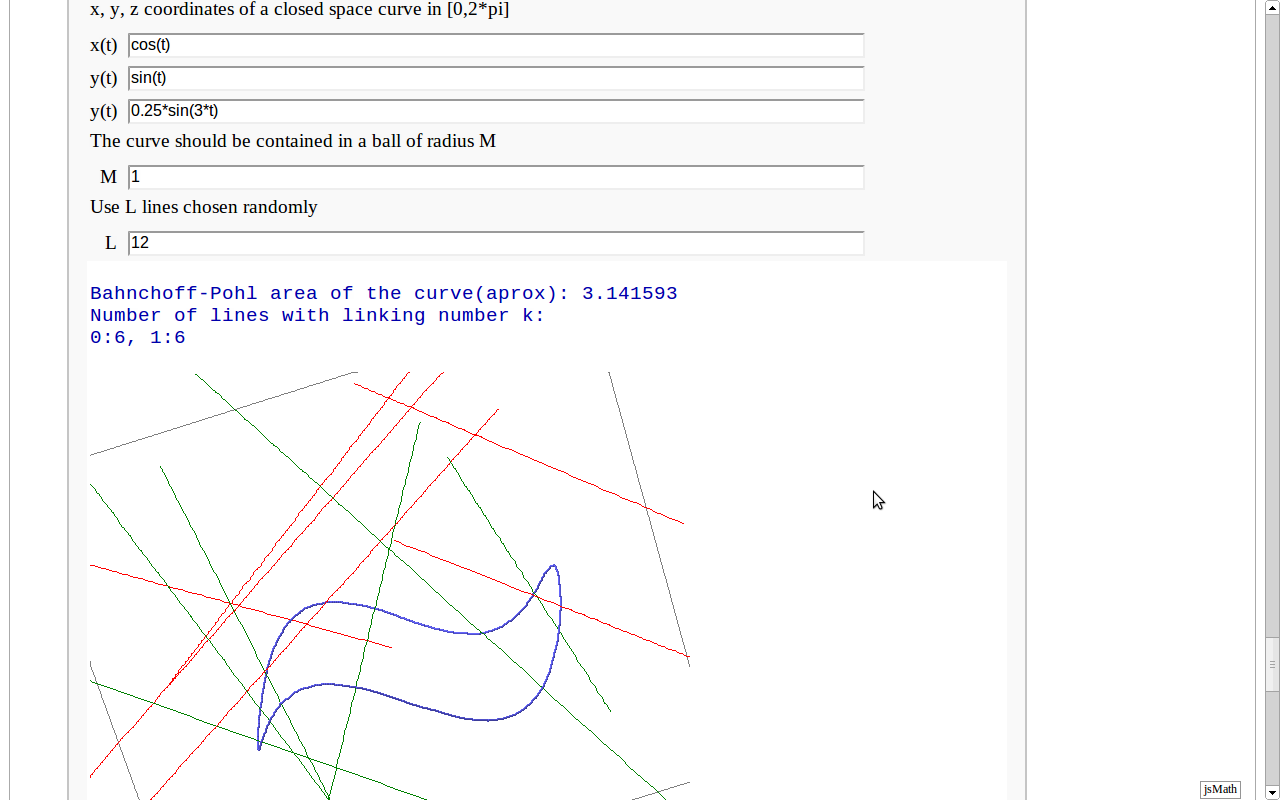|
Size: 34
Comment:
|
Size: 18428
Comment:
|
| Deletions are marked like this. | Additions are marked like this. |
| Line 1: | Line 1: |
| Describe interact/geometry here. | = Sage Interactions - Geometry = goto [[interact|interact main page]] <<TableOfContents>> == Intersecting tetrahedral reflections == by Marshall Hampton. Inspired by a question from Hans Schepker of Glass Geometry. {{{#!sagecell #Pairs of tetrahedra, one the reflection of the other in the internal face, are joined by union operations: p1 = Polyhedron(vertices = [[1,1,1],[1,1,0],[0,1,1],[1,0,1]]) p2 = Polyhedron(vertices = [[1/3,1/3,1/3],[1,1,0],[0,1,1],[1,0,1]]) p12 = p1.union(p2) p3 = Polyhedron(vertices = [[0,0,1],[0,0,0],[0,1,1],[1,0,1]]) p4 = Polyhedron(vertices = [[2/3,2/3,1/3],[0,0,0],[0,1,1],[1,0,1]]) p34 = p3.union(p4) p5 = Polyhedron(vertices = [[1,0,0],[1,0,1],[0,0,0],[1,1,0]]) p6 = Polyhedron(vertices = [[1/3,2/3,2/3],[1,0,1],[0,0,0],[1,1,0]]) p56 = p5.union(p6) p7 = Polyhedron(vertices = [[0,1,0],[0,0,0],[1,1,0],[0,1,1]]) p8 = Polyhedron(vertices = [[2/3,1/3,2/3],[0,0,0],[1,1,0],[0,1,1]]) p78 = p7.union(p8) pti = p12.intersection(p34).intersection(p56).intersection(p78) @interact def tetra_plot(opac = slider(srange(0,1.0,.25), default = .25)): p12r = p12.render_wireframe()+p12.render_solid(opacity = opac) p34r = p34.render_wireframe()+p34.render_solid(rgbcolor = (0,0,1),opacity = opac) p56r = p56.render_wireframe()+p56.render_solid(rgbcolor = (0,1,0),opacity = opac) p78r = p78.render_wireframe()+p78.render_solid(rgbcolor = (0,1,1),opacity = opac) ptir = pti.render_wireframe()+pti.render_solid(rgbcolor = (1,0,1),opacity = .9) show(p12r+p34r+p56r+p78r+ptir, frame = False) }}} {{attachment:tetrareflect.png}} == Evolutes == by Pablo Angulo. Computes the evolute of a plane curve given in parametric coordinates. The curve must be parametrized from the interval [0,2pi]. {{{#!sagecell var('t'); def norma(v): return sqrt(sum(x^2 for x in v)) paso_angulo=5 @interact def _( gamma1=input_box(default=sin(t)), gamma2=input_box(default=1.3*cos(t)), draw_normal_lines=True, rango_angulos=range_slider(0,360,paso_angulo,(0,90),label='Draw lines for these angles'), draw_osculating_circle=True, t0=input_box(default=pi/3,label='parameter value for the osculating circle'), auto_update=False ): gamma=(gamma1,gamma2) gammap=(gamma[0].derivative(),gamma[1].derivative()) np=norma(gammap) gammapp=(gammap[0].derivative(),gammap[1].derivative()) npp=norma(gammapp) normal=(gammap[1]/np, -gammap[0]/np) curvatura=(gammap[1]*gammapp[0]-gammap[0]*gammapp[1])/norma(gammap)^3 radio=1/curvatura centros=(gamma[0]+radio*normal[0],gamma[1]+radio*normal[1]) curva=parametric_plot(gamma,(t,0,2*pi)) evoluta=parametric_plot(centros,(t,0,2*pi), color='red') grafica=curva+evoluta if draw_normal_lines: f=2*pi/360 lineas=sum(line2d( [ (gamma[0](t=i*f), gamma[1](t=i*f)), (centros[0](t=i*f), centros[1](t=i*f)) ], thickness=1,rgbcolor=(1,0.8,0.8)) for i in range(rango_angulos[0], rango_angulos[1]+paso_angulo, paso_angulo)) grafica+=lineas if draw_osculating_circle and 0<t0<2*pi: punto=point((gamma[0](t=t0), gamma[1](t=t0)), rgbcolor=hue(0),pointsize=30) circulo=circle( (centros[0](t=t0), centros[1](t=t0)), radio(t=t0) ) grafica+=punto+circulo show(grafica,aspect_ratio=1,xmin=-2,xmax=2,ymin=-2,ymax=2) }}} {{attachment:evoluta3.png}} == Geodesics on a parametric surface == by Antonio Valdés and Pablo Angulo. A first interact allows the user to introduce a parametric surface, and draws it. Then a second interact draws a geodesic within the surface. The separation is so that after the first interact, the geodesic equations are "compiled", and then the second interact is faster. {{{#!sagecell u, v, t = var('u v t') @interact def _(x = input_box(3*sin(u)*cos(v), 'x'), y = input_box(sin(u)*sin(v), 'y'), z = input_box(2*cos(u), 'z'), _int_u = input_grid(1, 2, default = [[0,pi]], label = 'u -interval'), _int_v = input_grid(1, 2, default = [[-pi,pi]], label = 'v -interval')): global F, Fu, Fv, func, S_plot, int_u, int_v int_u = _int_u[0] int_v = _int_v[0] F = vector([x, y, z]) S_plot = parametric_plot3d( F, (u, int_u[0], int_u[1]), (v, int_v[0], int_v[1])) S_plot.show(aspect_ratio = [1, 1, 1]) dFu = F.diff(u) dFv = F.diff(v) Fu = fast_float(dFu, u, v) Fv = fast_float(dFv, u, v) ufunc = function('ufunc', t) vfunc = function('vfunc', t) dFtt = F(u=ufunc, v=vfunc).diff(t, t) ec1 = dFtt.dot_product(dFu(u=ufunc, v=vfunc)) ec2 = dFtt.dot_product(dFv(u=ufunc, v=vfunc)) dv, ddv, du, ddu = var('dv, ddv, du, ddu') diffec1 = ec1.subs_expr(diff(ufunc, t) == du, diff(ufunc, t, t) == ddu, diff(vfunc, t) == dv, diff(vfunc, t, t) == ddv, ufunc == u, vfunc == v) diffec2 = ec2.subs_expr(diff(ufunc, t) == du, diff(ufunc, t, t) == ddu, diff(vfunc, t) == dv, diff(vfunc, t, t) == ddv, ufunc == u, vfunc == v) sols = solve([diffec1 == 0 , diffec2 == 0], ddu, ddv) ddu_rhs = (sols[0][0]).rhs().full_simplify() ddv_rhs = (sols[0][1]).rhs().full_simplify() ddu_ff = fast_float(ddu_rhs, du, dv, u, v) ddv_ff = fast_float(ddv_rhs, du, dv, u, v) def func(y,t): v = list(y) return [ddu_ff(*v), ddv_ff(*v), v[0], v[1]] }}} {{attachment:geodesics1.png}} {{{#!sagecell from scipy.integrate import odeint def fading_line3d(points, rgbcolor1, rgbcolor2, *args, **kwds): L = len(points) vcolor1 = vector(RDF, rgbcolor1) vcolor2 = vector(RDF, rgbcolor2) return sum(line3d(points[j:j+2], rgbcolor = tuple( ((L-j)/L)*vcolor1 + (j/L)*vcolor2 ), *args, **kwds) for j in srange(L-1)) steps = 100 @interact def _(u_0 = slider(int_u[0], int_u[1], (int_u[1] - int_u[0])/100, default = (int_u[0] + int_u[1])/2, label = 'u_0'), v_0 = slider(int_v[0], int_v[1], (int_v[1] - int_v[0])/100, default = (int_v[0] + int_v[1])/2, label = 'v_0'), V_u = slider(-10, 10, 1/10, default = 1, label = 'V_u'), V_v = slider(-10, 10, 1/10, default = 0, label = 'V_v'), int_s = slider(0, 10, 1/10, default = (int_u[1] - int_u[0])/2, label = 'geodesic interval'), sliding_color = checkbox(True,'change color along the geodesic')): du, dv, u, v = var('du dv u v') Point = [u_0, v_0] velocity = [V_u, V_v] Point = map(float, Point) velocity = map(float, velocity) geo2D_aux = odeint(func, y0 = [velocity[0], velocity[1], Point[0], Point[1]], t = srange(0, int_s, 0.01)) geo3D = [F(u=l,v=r) for [j, k, l, r] in geo2D_aux] if sliding_color: g_plot = fading_line3d(geo3D, rgbcolor1 = (1, 0, 0), rgbcolor2 = (0, 1, 0), thickness=4) else: g_plot = line3d(geo3D, rgbcolor=(0, 1, 0), thickness=4) P = F(u=Point[0], v=Point[1]) P_plot = point3d((P[0], P[1], P[2]), rgbcolor = (0, 0, 0), pointsize = 30) V = velocity[0] * Fu(u = Point[0], v = Point[1]) + \ velocity[1] * Fv(u= Point[0], v = Point[1]) V_plot = arrow3d(P, P + V, color = 'black') show(g_plot + S_plot + V_plot + P_plot,aspect_ratio = [1, 1, 1]) }}} {{attachment:geodesics2.png}} == Dimensional Explorer == By Eviatar Bach Renders 2D images (perspective or spring-layout) and 3D models of 0-10 dimensional hypercubes. It also displays number of edges and vertices. {{{#!sagecell @interact def render(Display=selector(['2D Perspective', '2D Spring-layout', '3D']), Dimension=slider(0,10,default=4, step_size=1), Size=slider(0,10,default=5,step_size=1), Vertices=False, Calculations=False): if Display=='2D Perspective': if Dimension==0: g=graphs.GridGraph([1]) print 'Vertices:', len(g.vertices()), ('(2^%s)'%Dimension if Calculations else ''), '\nEdges:', len(g.edges()), ('(%s*(%s/2))' %(len(g.vertices()), Dimension) if Calculations else '') g.show(figsize=[Size,Size], vertex_size=30, vertex_labels=False, transparent=True, vertex_colors='black') else: g=graphs.CubeGraph(Dimension) print 'Vertices:', len(g.vertices()), ('(2^%s)'%Dimension if Calculations else ''), '\nEdges:', len(g.edges()), ('(%s*(%s/2))' %(len(g.vertices()), Dimension) if Calculations else '') g.show(figsize=[Size,Size], vertex_size=(20 if Vertices else 0), vertex_labels=False, transparent=True, vertex_colors='black') if Display=='2D Spring-layout': if Dimension==0: s=graphs.GridGraph([1]) print 'Vertices:', len(s.vertices()), ('(2^%s)'%Dimension if Calculations else ''), '\nEdges:', len(s.edges()), ('(%s*(%s/2))' %(len(s.vertices()), Dimension) if Calculations else '') s.show(figsize=[Size,Size], vertex_size=30, vertex_labels=False, transparent=True, vertex_colors='black') else: s=graphs.GridGraph([2]*Dimension) print 'Vertices:', len(s.vertices()), ('(2^%s)'%Dimension if Calculations else ''), '\nEdges:', len(s.edges()), ('(%s*(%s/2))' %(len(s.vertices()), Dimension) if Calculations else '') s.show(figsize=[Size,Size], vertex_size=(20 if Vertices else 0), vertex_labels=False, transparent=True, vertex_colors='black') if Display=='3D': if Dimension==0: d=graphs.GridGraph([1]) print 'Vertices:', len(d.vertices()), ('(2^%s)'%Dimension if Calculations else ''), '\nEdges:', len(d.edges()), ('(%s*(%s/2))' %(len(d.vertices()), Dimension) if Calculations else '') d.show3d(figsize=[Size/2,Size/2], vertex_size=0.001) else: d=graphs.CubeGraph(Dimension) print 'Vertices:', len(d.vertices()), ('(2^%s)'%Dimension if Calculations else ''), '\nEdges:', len(d.edges()), ('(%s*(%s/2))' %(len(d.vertices()), Dimension) if Calculations else '') d.show3d(figsize=[Size,Size], vertex_size=(0.03 if Vertices else 0.001)) }}} {{attachment:dimensions.png}} == Crofton's formula == by Pablo Angulo. Illustrates [[http://en.wikipedia.org/wiki/Crofton%27s_formula| Crofton's formula]] by throwing some random lines and computing the intersection number with a given curve. May use either solve for exact computation of the intersections, or may also approximate the curve by straight segments (this is the default). {{{ from collections import defaultdict var('t x y') pin = pi.n() def longitud(curva, t0, t1): dxdt = derivative(curva[0], t) dydt = derivative(curva[1], t) integrando(t) = sqrt(dxdt^2 + dydt^2) i,_ = numerical_integral(integrando, t0, t1) return i def random_line(cota): theta = random()*pin k = 2*cota*random() - cota return sin(theta)*x + cos(theta)*y + k def crofton_exact(curva, t0, t1, L, M): forget() assume(t>t0) assume(t<t1) pp = parametric_plot(curva, (t, t0, t1), color='red') cortesd = defaultdict(int) for k in range(L): rl = random_line(M) ss = solve(rl(x=curva[0], y=curva[1]), t) cortes = 0 for s in ss: tt = s.rhs() x0,y0 = curva[0](t=tt), curva[1](t=tt) if x0 in RR and y0 in RR: pp += point2d((x0,y0), pointsize = 30) cortes += 1 if cortes: pp += implicit_plot(rl, (x,-M,M), (y,-M,M), color='green') else: pp += implicit_plot(rl, (x,-M,M), (y,-M,M), color='blue') cortesd[cortes] += 1 return cortesd, pp def random_line_n(cota): theta = random()*pin k = 2*cota*random() - cota return sin(theta), cos(theta), k def interseccion_sr(punto1, punto2, recta): 'Devuelve el punto de interseccion de una recta y un segmento, o None si no se cortan' x1, y1 = punto1 x2, y2 = punto2 a, b, c = recta num = (-c - a*x1 - b*y1) den = (a*(x2 - x1) + b*(y2 - y1)) if (0 < num < den) or (den < num < 0): t_i = num/den return ((1-t_i)*x1 + t_i*x2, (1-t_i)*y1 + t_i*y2) else: return None def interseccion_cr(curva, t0, t1, recta, partes=50): '''Devuelve el numero de puntos de interseccion de una curva y una recta''' x,y = curva paso = (t1 - t0)/partes puntos = [(x(t=tr), y(t=tr)) for tr in srange(t0, t1 + paso, paso)] intersecciones = (interseccion_sr(puntos[j], puntos[j+1], recta) for j in xrange(partes-1)) return [p for p in intersecciones if p ] def crofton_aprox(curva, t0, t1, L, M): cortesd = defaultdict(int) pp = parametric_plot(curva, (t, t0, t1), color='red') for k in range(L): a,b,c = random_line_n(M) rl = a*x + b*y + c cortes = interseccion_cr(curva, t0, t1, (a,b,c)) if cortes: pp += sum(point2d(p, pointsize = 30) for p in cortes) pp += implicit_plot(rl, (x,-M,M), (y,-M,M), color='green') else: pp += implicit_plot(rl, (x,-M,M), (y,-M,M), color='blue') cortesd[len(cortes)] += 1 return cortesd, pp def print_stats(d): print 'Number of lines with k intersection points:' print ', '.join('%d:%d'%(k,v) for k,v in d.iteritems()) }}} {{{ @interact def crofton_interact(u1 = text_control('x and y coordinates of curve'), curvax = input_box(t^2, label='x(t)' ), curvay = input_box(2*t-1, label='y(t)' ), u2 = text_control('Interval of definition'), t0 = 0, t1 = 1, u3 = text_control('Draw L lines randomly cos(t)x + sin(t)y + K, |K|<M, 0 <= t < 2pi'), M = 2, L = 5, u4 = text_control('Use function "solve" from maxima for exact computations?'), exact = checkbox(False), u5 = text_control('Otherwise, a curve is approximated by how many segments?'), steps = slider(4, 40, 4, 8)): if exact: cortesd, p = crofton_exact((curvax, curvay), t0, t1, L, M) else: cortesd, p = crofton_aprox((curvax, curvay), t0, t1, L, M) p.show(aspect_ratio=1, xmin=-2, xmax=2, ymin=-2,ymax=2) print 'A curve of lenght %f'%longitud((curvax, curvay), t0, t1) print_stats(cortesd) cortes_tot = sum(k*v for k,v in cortesd.iteritems()) print 'Approx length using Crofton\'s formula: %f'%((cortes_tot/L)*(pi*M)) }}} {{attachment:crofton4.png}} == Banchoff-Pohl area == by Pablo Angulo. Computes the Banchoff-Pohl "area enclosed by a spatial curve", by throwing some random lines and computing the linking number with the given curve. Lines not linked to the given curve are displayed in red, linked lines are displayed in green. {{{#!sagecell from collections import defaultdict var('t') a = 0; b= 2*pi def random_line3d(bound): '''Random line in R^3: first choose the guiding vector of the line, then choose a point in the plane p perpendicular to that vector. ''' p = vector([(2*random() - 1) for _ in range(3)]) v = p/norm(p) v2, v3 = matrix(v).right_kernel().basis() if det(matrix([v, v2, v3]))<0: v2, v3 = v3, v2 v2 = v2/norm(v2) v3 = v3 - (v3*v2)*v2 v3 = v3/norm(v3) return v, (2*random()*bound - bound, v2), (2*random()*bound - bound, v3) def winding_number(x, y, x0, y0): x -= x0 y -= y0 r2 = x^2 + y^2 xp = x.derivative(t) yp = y.derivative(t) integrando(t) = (x*yp -y*xp)/r2 i,e = numerical_integral(integrando, a, b) return round(i/(2*pi)) def linking_number(curve, line): v, (a2, v2), (a3, v3) = line M = matrix([v, v2, v3]) # curve2d = (curve*M.inverse())[1:] #This is VERY slow, for some reason! curve2d = sum(c*v for c,v in zip(curve,M.inverse()))[1:] x, y = curve2d return winding_number(x, y, a2,a3) def color_ln(number): if number: return (0,1-1/(1+number),0) else: return (1,0,0) def banchoff_pohl(curve, L, M): ln_d = defaultdict(int) pp = parametric_plot3d(curve, (t,0,2*pi), thickness=2) for k in range(L): a_line = random_line3d(M) ln = abs(linking_number(curve, a_line)) v, (l1, v1), (l2, v2) = a_line pp += parametric_plot3d(l1*v1+l2*v2+t*v,(t,-2,2), color=color_ln(ln)) ln_d[ln] += 1 return ln_d, pp def print_stats(d): print 'Number of lines with linking number k:' print ', '.join('%d:%d'%(k,v) for k,v in d.iteritems()) @interact def bp_interact( u1 = text_control('x, y, z coordinates of a closed space curve in [0,2*pi]'), curvax = input_box(cos(t), label='x(t)' ), curvay = input_box(sin(t), label='y(t)' ), curvaz = input_box(0, label='y(t)' ), u2 = text_control('The curve should be contained in a ball of radius M'), M = 1, u3 = text_control('Use L lines chosen randomly'), L = 10): ln_d, p = banchoff_pohl(vector((curvax, curvay, curvaz)), L, M) p.show(aspect_ratio=1, xmin=-2, xmax=2, ymin=-2,ymax=2) bp_area_aprox = (sum(k^2*v for k,v in ln_d.iteritems())/L)*2*pi*M^2 print 'Bahnchoff-Pohl area of the curve(aprox): %f'%bp_area_aprox print_stats(ln_d) }}} {{attachment:banchoff-pohl.png}} |
Sage Interactions - Geometry
goto interact main page
Contents
Intersecting tetrahedral reflections
by Marshall Hampton. Inspired by a question from Hans Schepker of Glass Geometry.
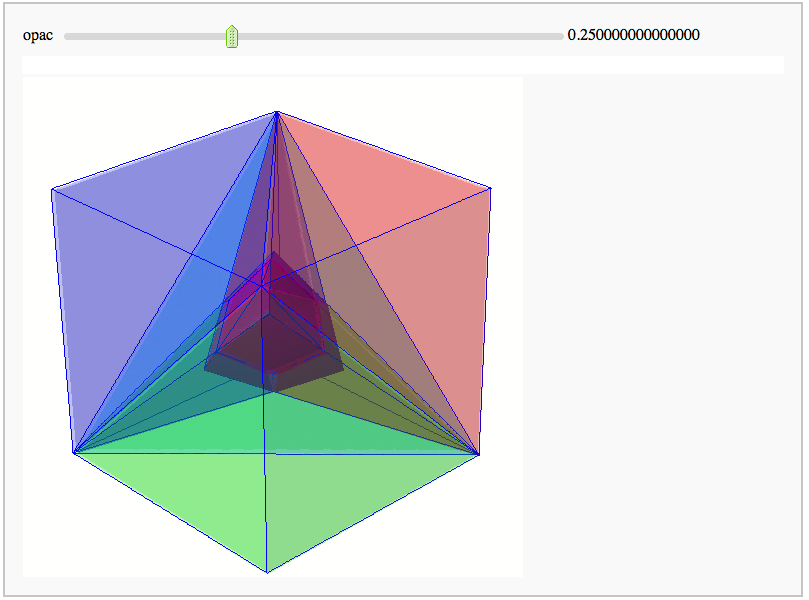
Evolutes
by Pablo Angulo. Computes the evolute of a plane curve given in parametric coordinates. The curve must be parametrized from the interval [0,2pi].
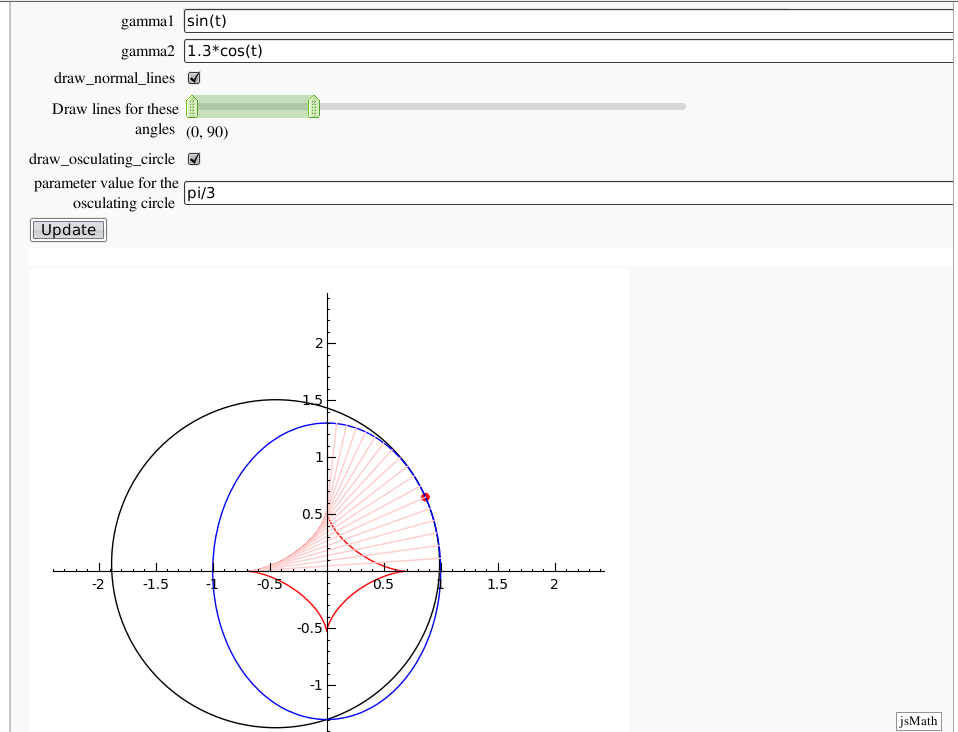
Geodesics on a parametric surface
by Antonio Valdés and Pablo Angulo. A first interact allows the user to introduce a parametric surface, and draws it. Then a second interact draws a geodesic within the surface. The separation is so that after the first interact, the geodesic equations are "compiled", and then the second interact is faster.
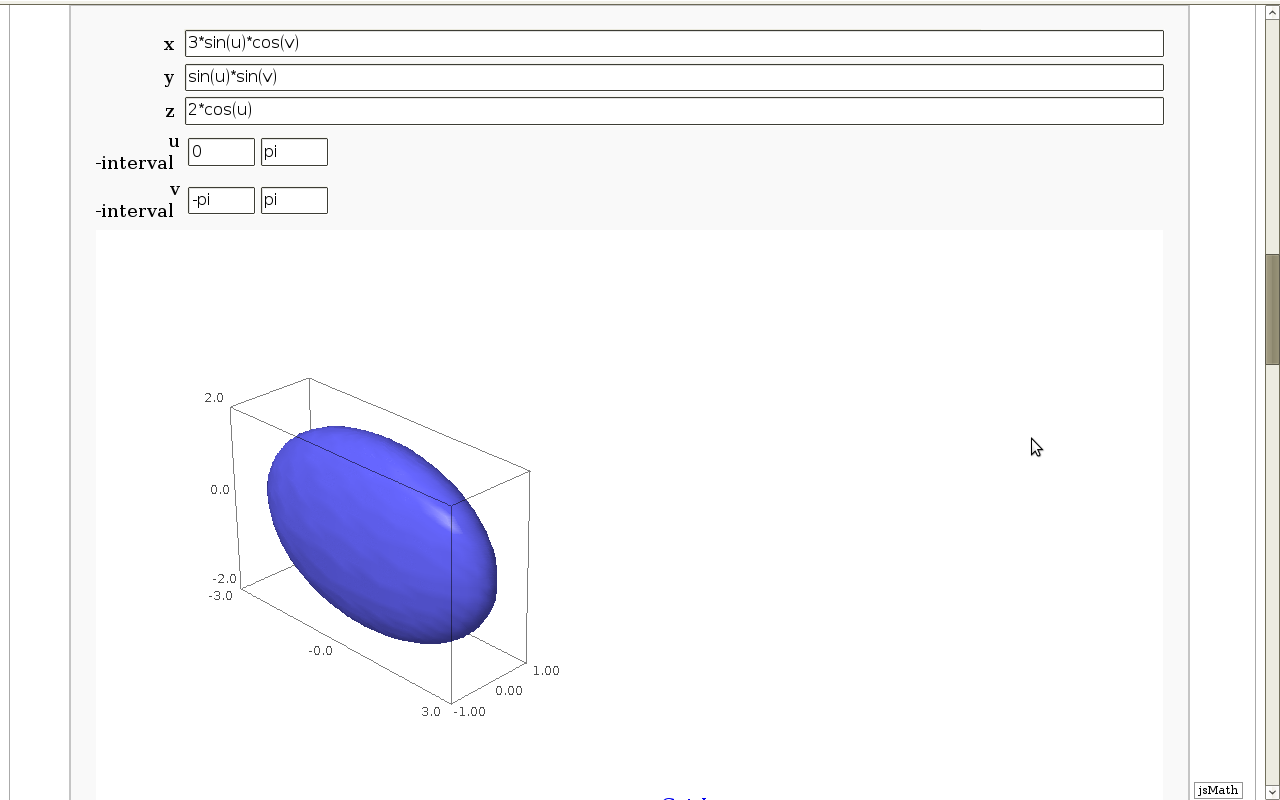
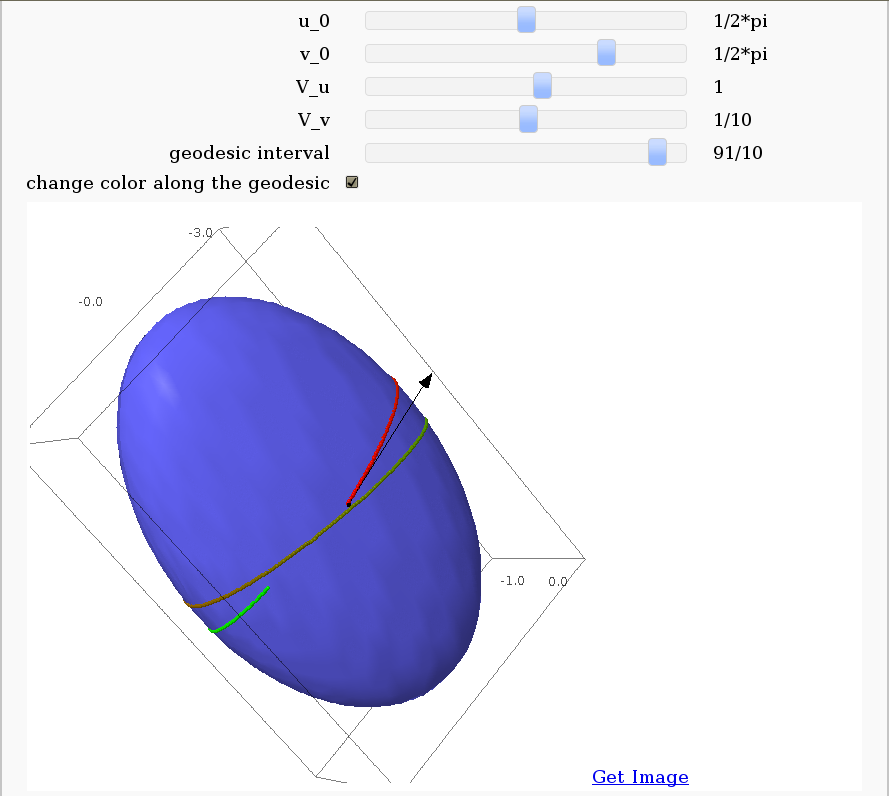
Dimensional Explorer
By Eviatar Bach
Renders 2D images (perspective or spring-layout) and 3D models of 0-10 dimensional hypercubes. It also displays number of edges and vertices.
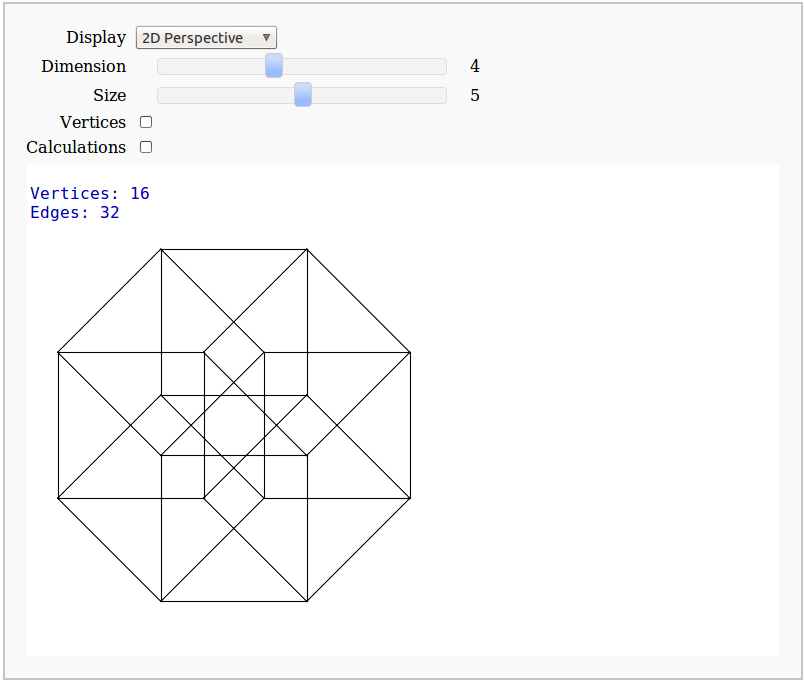
Crofton's formula
by Pablo Angulo. Illustrates Crofton's formula by throwing some random lines and computing the intersection number with a given curve. May use either solve for exact computation of the intersections, or may also approximate the curve by straight segments (this is the default).
from collections import defaultdict
var('t x y')
pin = pi.n()
def longitud(curva, t0, t1):
dxdt = derivative(curva[0], t)
dydt = derivative(curva[1], t)
integrando(t) = sqrt(dxdt^2 + dydt^2)
i,_ = numerical_integral(integrando, t0, t1)
return i
def random_line(cota):
theta = random()*pin
k = 2*cota*random() - cota
return sin(theta)*x + cos(theta)*y + k
def crofton_exact(curva, t0, t1, L, M):
forget()
assume(t>t0)
assume(t<t1)
pp = parametric_plot(curva, (t, t0, t1), color='red')
cortesd = defaultdict(int)
for k in range(L):
rl = random_line(M)
ss = solve(rl(x=curva[0], y=curva[1]), t)
cortes = 0
for s in ss:
tt = s.rhs()
x0,y0 = curva[0](t=tt), curva[1](t=tt)
if x0 in RR and y0 in RR:
pp += point2d((x0,y0), pointsize = 30)
cortes += 1
if cortes:
pp += implicit_plot(rl, (x,-M,M), (y,-M,M), color='green')
else:
pp += implicit_plot(rl, (x,-M,M), (y,-M,M), color='blue')
cortesd[cortes] += 1
return cortesd, pp
def random_line_n(cota):
theta = random()*pin
k = 2*cota*random() - cota
return sin(theta), cos(theta), k
def interseccion_sr(punto1, punto2, recta):
'Devuelve el punto de interseccion de una recta y un segmento, o None si no se cortan'
x1, y1 = punto1
x2, y2 = punto2
a, b, c = recta
num = (-c - a*x1 - b*y1)
den = (a*(x2 - x1) + b*(y2 - y1))
if (0 < num < den) or (den < num < 0):
t_i = num/den
return ((1-t_i)*x1 + t_i*x2, (1-t_i)*y1 + t_i*y2)
else:
return None
def interseccion_cr(curva, t0, t1, recta, partes=50):
'''Devuelve el numero de puntos de interseccion de una curva y una recta'''
x,y = curva
paso = (t1 - t0)/partes
puntos = [(x(t=tr), y(t=tr)) for tr in srange(t0, t1 + paso, paso)]
intersecciones = (interseccion_sr(puntos[j], puntos[j+1], recta)
for j in xrange(partes-1))
return [p for p in intersecciones if p ]
def crofton_aprox(curva, t0, t1, L, M):
cortesd = defaultdict(int)
pp = parametric_plot(curva, (t, t0, t1), color='red')
for k in range(L):
a,b,c = random_line_n(M)
rl = a*x + b*y + c
cortes = interseccion_cr(curva, t0, t1, (a,b,c))
if cortes:
pp += sum(point2d(p, pointsize = 30) for p in cortes)
pp += implicit_plot(rl, (x,-M,M), (y,-M,M), color='green')
else:
pp += implicit_plot(rl, (x,-M,M), (y,-M,M), color='blue')
cortesd[len(cortes)] += 1
return cortesd, pp
def print_stats(d):
print 'Number of lines with k intersection points:'
print ', '.join('%d:%d'%(k,v) for k,v in d.iteritems())@interact
def crofton_interact(u1 = text_control('x and y coordinates of curve'),
curvax = input_box(t^2, label='x(t)' ),
curvay = input_box(2*t-1, label='y(t)' ),
u2 = text_control('Interval of definition'),
t0 = 0, t1 = 1,
u3 = text_control('Draw L lines randomly cos(t)x + sin(t)y + K, |K|<M, 0 <= t < 2pi'),
M = 2,
L = 5,
u4 = text_control('Use function "solve" from maxima for exact computations?'),
exact = checkbox(False),
u5 = text_control('Otherwise, a curve is approximated by how many segments?'),
steps = slider(4, 40, 4, 8)):
if exact:
cortesd, p = crofton_exact((curvax, curvay), t0, t1, L, M)
else:
cortesd, p = crofton_aprox((curvax, curvay), t0, t1, L, M)
p.show(aspect_ratio=1, xmin=-2, xmax=2, ymin=-2,ymax=2)
print 'A curve of lenght %f'%longitud((curvax, curvay), t0, t1)
print_stats(cortesd)
cortes_tot = sum(k*v for k,v in cortesd.iteritems())
print 'Approx length using Crofton\'s formula: %f'%((cortes_tot/L)*(pi*M))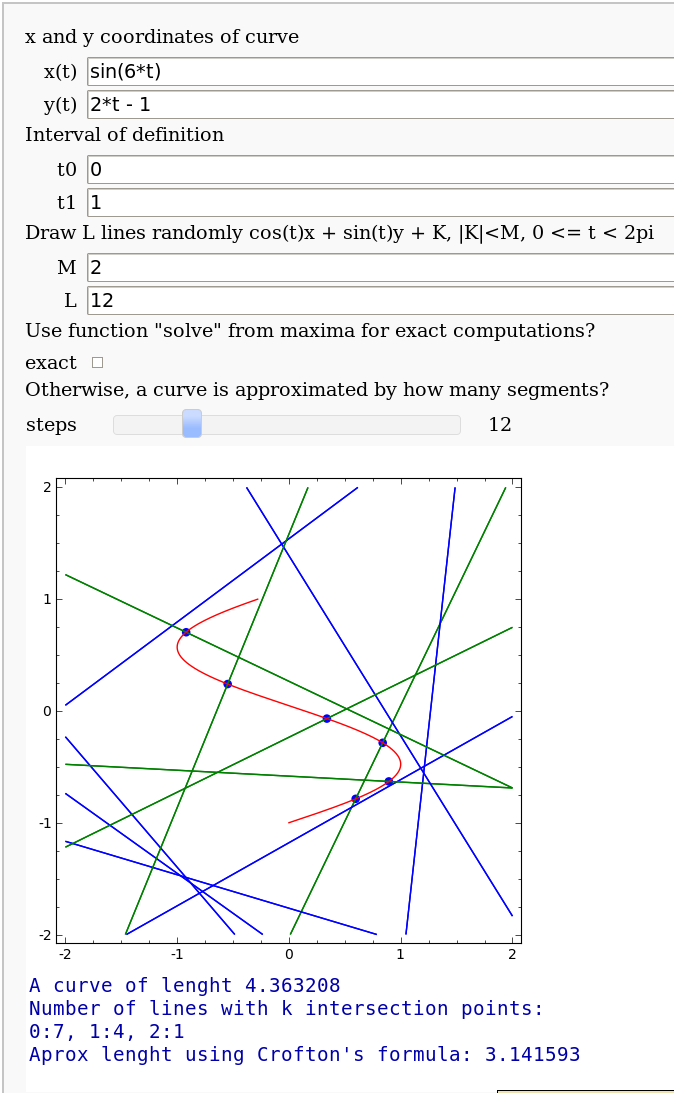
Banchoff-Pohl area
by Pablo Angulo. Computes the Banchoff-Pohl "area enclosed by a spatial curve", by throwing some random lines and computing the linking number with the given curve. Lines not linked to the given curve are displayed in red, linked lines are displayed in green.
